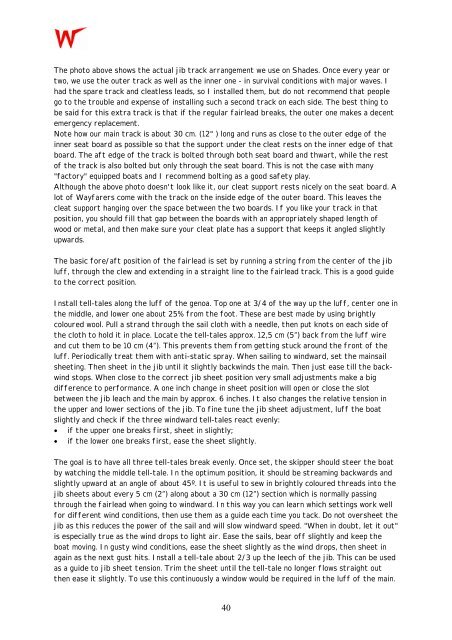File - Canadian Wayfarer Association
File - Canadian Wayfarer Association
File - Canadian Wayfarer Association
You also want an ePaper? Increase the reach of your titles
YUMPU automatically turns print PDFs into web optimized ePapers that Google loves.
The photo above shows the actual jib track arrangement we use on Shades. Once every year or<br />
two, we use the outer track as well as the inner one - in survival conditions with major waves. I<br />
had the spare track and cleatless leads, so I installed them, but do not recommend that people<br />
go to the trouble and expense of installing such a second track on each side. The best thing to<br />
be said for this extra track is that if the regular fairlead breaks, the outer one makes a decent<br />
emergency replacement.<br />
Note how our main track is about 30 cm. (12" ) long and runs as close to the outer edge of the<br />
inner seat board as possible so that the support under the cleat rests on the inner edge of that<br />
board. The aft edge of the track is bolted through both seat board and thwart, while the rest<br />
of the track is also bolted but only through the seat board. This is not the case with many<br />
"factory" equipped boats and I recommend bolting as a good safety play.<br />
Although the above photo doesn't look like it, our cleat support rests nicely on the seat board. A<br />
lot of <strong>Wayfarer</strong>s come with the track on the inside edge of the outer board. This leaves the<br />
cleat support hanging over the space between the two boards. If you like your track in that<br />
position, you should fill that gap between the boards with an appropriately shaped length of<br />
wood or metal, and then make sure your cleat plate has a support that keeps it angled slightly<br />
upwards.<br />
The basic fore/aft position of the fairlead is set by running a string from the center of the jib<br />
luff, through the clew and extending in a straight line to the fairlead track. This is a good guide<br />
to the correct position.<br />
Install tell-tales along the luff of the genoa. Top one at 3/4 of the way up the luff, center one in<br />
the middle, and lower one about 25% from the foot. These are best made by using brightly<br />
coloured wool. Pull a strand through the sail cloth with a needle, then put knots on each side of<br />
the cloth to hold it in place. Locate the tell-tales approx. 12,5 cm (5”) back from the luff wire<br />
and cut them to be 10 cm (4”). This prevents them from getting stuck around the front of the<br />
luff. Periodically treat them with anti-static spray. When sailing to windward, set the mainsail<br />
sheeting. Then sheet in the jib until it slightly backwinds the main. Then just ease till the backwind<br />
stops. When close to the correct jib sheet position very small adjustments make a big<br />
difference to performance. A one inch change in sheet position will open or close the slot<br />
between the jib leach and the main by approx. 6 inches. It also changes the relative tension in<br />
the upper and lower sections of the jib. To fine tune the jib sheet adjustment, luff the boat<br />
slightly and check if the three windward tell-tales react evenly:<br />
• if the upper one breaks first, sheet in slightly;<br />
• if the lower one breaks first, ease the sheet slightly.<br />
The goal is to have all three tell-tales break evenly. Once set, the skipper should steer the boat<br />
by watching the middle tell-tale. In the optimum position, it should be streaming backwards and<br />
slightly upward at an angle of about 45º. It is useful to sew in brightly coloured threads into the<br />
jib sheets about every 5 cm (2”) along about a 30 cm (12”) section which is normally passing<br />
through the fairlead when going to windward. In this way you can learn which settings work well<br />
for different wind conditions, then use them as a guide each time you tack. Do not oversheet the<br />
jib as this reduces the power of the sail and will slow windward speed. "When in doubt, let it out"<br />
is especially true as the wind drops to light air. Ease the sails, bear off slightly and keep the<br />
boat moving. In gusty wind conditions, ease the sheet slightly as the wind drops, then sheet in<br />
again as the next gust hits. Install a tell-tale about 2/3 up the leech of the jib. This can be used<br />
as a guide to jib sheet tension. Trim the sheet until the tell-tale no longer flows straight out<br />
then ease it slightly. To use this continuously a window would be required in the luff of the main.<br />
40


